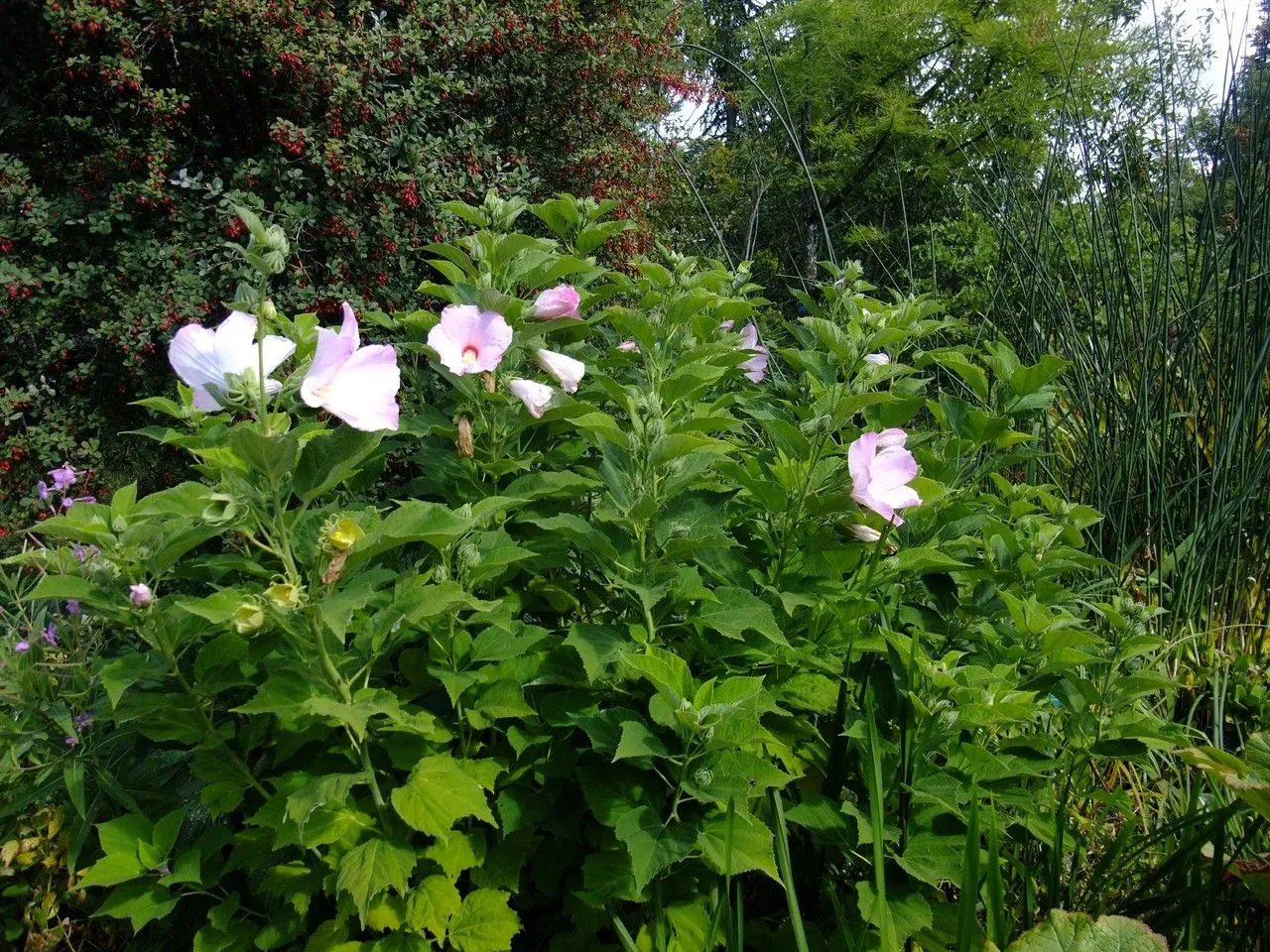
Author: L.
Bibliography: Sp. Pl.: 693 (1753)
Year: 1753
Status: accepted
Rank: species
Genus: Hibiscus
Vegetable: False
Observations: SE. Canada to C. & E. U.S.A. and NE. Mexico
The Mallow-rose, scientifically known as Hibiscus moscheutos, is a beautiful perennial plant belonging to the Malvaceae family. First described in 1753 by the renowned naturalist Carl Linnaeus, this striking species has captivated gardeners and botanists alike for centuries.
Native to a broad region stretching from southeastern Canada through central and eastern United States, and even reaching into northeastern Mexico, the Mallow-rose thrives in varied climates and environments. It typically favors wetlands, riverbanks, and marshy areas, where it can benefit from the consistent moisture and nutrient-rich soil these habitats provide. This adaptability has earned the plant a widespread distribution within its natural range.
One of the most distinguishing features of the Mallow-rose is its large, showy flowers, which can reach up to 6-8 inches in diameter. These blossoms are often found in shades of white, pink, and red, creating a stunning visual contrast against the plant’s lush, green foliage. Each flower, although short-lived, blooms prolifically, ensuring a continuous display of vibrant color throughout the summer and into early fall. The heart of the flower is typically adorned with a prominent, contrasting eye, adding to its ornamental appeal.
The leaves of Hibiscus moscheutos are equally noteworthy, with a velvety texture and a shape that ranges from ovate to lanceolate. These leaves contribute to the plant’s ability to create a dense, shrub-like appearance, making it an excellent choice for use in garden borders, naturalized plantings, or as a focal point in landscape design.
Beyond its aesthetic value, the Mallow-rose has also been acknowledged for its ecological contributions. The flowers attract a range of pollinators, including bees, butterflies, and hummingbirds, thus playing a vital role in local ecosystems. Additionally, its robust growth can help stabilize soil and prevent erosion in wetland areas.
In cultivation, Hibiscus moscheutos is relatively easy to grow, provided its basic needs are met. It thrives in full sun and appreciates regular watering, particularly in drier periods. While it can handle a variety of soil types, it performs best in rich, well-drained soils. Gardeners often prize it for its minimal pest problems and overall hardiness.
In summary, Hibiscus moscheutos, or the Mallow-rose, is a standout species within the Malvaceae family, known for its impressive flowers, ecological benefits, and versatile cultivation characteristics. Its historical and botanical significance, widespread natural range, and ornamental beauty make it a cherished addition to both natural landscapes and cultivated gardens.
Eng: common rose-mallow, crimsoneyed rosemallow, mallow-rose, sea-hollyhock, swamp rose-mallow, swamp rosemallow, water-mallow, crimson-eyed rose-mallow, sea hollyhock, water mallow
Por: hibiscus
Swe: sumphibiskus
Fra: ketmie des marais
En: Mallow-rose, Swamp rose-mallow, Water-mallow, Common rose-mallow, Sea-hollyhock, Crimsoneyed rosemallow, Crimson-Eyed Rose-Mallow, Swamp rosemallow, Crimsoneyes rosemallow, Sea hollyhock, Water mallow
Zh: 芙蓉葵
Cs: Ibišek bahenní
Fi: Jättihibiskus
Fr: Ketmie des marais
De: Sumpfeibisch
Hu: Óriás hibiszkusz
Ml: ഹൈബിസ്കസ് മോസ്ക്യൂോടോസ്
Pt: Hibiscus
Sv: Sumphibiskus, Rosenhibiskus
Taken Aug 9, 2019 by Remi Jaffrelot (cc-by-sa)
Taken Aug 15, 2021 by Dieter Wagner (cc-by-sa)
Taken Jul 6, 2017 by Chantal Cd (cc-by-sa)
Taken Aug 27, 2017 by Garrett Gough (cc-by-sa)
Taken Jul 14, 2021 by carine gaborit (cc-by-sa)
Taken Sep 16, 2019 by Wilhelm Rogmann (cc-by-sa)
Taken Oct 1, 2020 by Dieter Albrecht (cc-by-sa)
Taken Aug 26, 2020 by Marco Dansereau (cc-by-sa)
Taken Sep 21, 2019 by raspiasse marcel (cc-by-sa)
Taken Jul 19, 2019 by jeffemcfresh (cc-by-sa)
Taken Jul 22, 2021 by William Coville (cc-by-sa)
Taken Apr 28, 2022 by Angelica Ridgedell (cc-by-sa)
Taken Mar 3, 2021 by Dieter Wagner (cc-by-sa)
Taken Oct 23, 2022 by Karolane Lapointe Champagne (cc-by-sa)
Taken Nov 13, 2020 by Abrego Saldaña Mateo (cc-by-sa)
© copyright of the Board of Trustees of the Royal Botanic Gardens, Kew.
© copyright of the Board of Trustees of the Royal Botanic Gardens, Kew.
© copyright of the Board of Trustees of the Royal Botanic Gardens, Kew.
Taken Aug 24, 2014 by Tela Botanica − Yoan MARTIN (cc-by-sa)
Taken Jul 24, 2007 by EOL − Ron Thomas (cc-by-nc-sa)
Taken Jan 19, 2016 by EOL − srall (cc-by-nc)
Taken Feb 3, 2022 by William Coville (cc-by-sa)
Taken Apr 25, 2020 by Larry Else (cc-by-sa)
Taken Aug 22, 2022 by Philippe Comte (cc-by-sa)
Taken Jan 1, 1900 by EOL − Gerrit Davidse (cc-by-nc-sa)
Taken Aug 24, 2014 by Tela Botanica − Yoan MARTIN (cc-by-sa)
Taken Sep 3, 2022 by Chris Griggs (cc-by-sa)
Taken Aug 18, 2015 by EOL − Summit Metro Parks (cc-by)
Taken Jul 24, 2022 by Perry Perry Rancourt (cc-by-sa)
Taken Jul 24, 2007 by EOL − Ron Thomas (cc-by-nc-sa)
Taken Jan 27, 2014 by EOL − Park Visitor (cc-by-nc)
Taken Feb 3, 2022 by William Coville (cc-by-sa)
Taken Feb 4, 2021 by Torbellino (cc-by-sa)
Growth form: Multiple Stem
Growth habit: Subshrub, Forb/herb
Growth rate: Rapid
Ph maximum: 7.5
Ph minimum: 4.0
Family: Myrtaceae Author: (F.Muell.) K.D.Hill & L.A.S.Johnson Bibliography: Telopea 6: 402 (1995) Year: 1995 Status:…
Family: Rubiaceae Author: Pierre ex A.Froehner Bibliography: Notizbl. Bot. Gart. Berlin-Dahlem 1: 237 (1897) Year:…
Family: Sapindaceae Author: Koidz. Bibliography: J. Coll. Sci. Imp. Univ. Tokyo 32(1): 38 (1911) Year:…
Family: Asteraceae Author: A.Gray Bibliography: Pacif. Railr. Rep.: 107 (1857) Year: 1857 Status: accepted Rank:…
Family: Fabaceae Author: Medik. Bibliography: Vorles. Churpfälz. Phys.-Ökon. Ges. 2: 398 (1787) Year: 1787 Status:…
Family: Aspleniaceae Author: (Cav.) Alston Bibliography: Bull. Misc. Inform. Kew 1932: 309 (1932) Year: 1932…